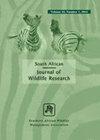And Then There was One: A Camera Trap Survey of the Declining Population of African Elephants in Knysna, South Africa
引用次数: 9
Abstract
Conservation agencies rely on accurate wildlife population estimates to inform management practices. The importance of accuracy increases with smaller, threatened populations, but so too does the challenge in achieving it, especially for evasive species in low-visibility terrain. Non-invasive survey techniques have been successfully applied in such conditions; however, each technique bears a unique set of limitations and often deliver different results. The shy Knysna elephants (Loxodonta africana) occur at extremely low numbers in difficult terrain, and the past few decades have seen debates raging about their numbers, fuelled in part by differing survey outcomes, although a decline has been apparent over the last 150 years. We surveyed the known range of the Knysna elephant population for 15 months (July 2016 – October 2017), using camera traps, and identified one adult female elephant. The reliability of using camera trapping for surveying animal populations in conditions such as the Knysna elephant is compared with the previous faecal DNA genotyping survey. We conclude that this population has declined to a single individual and discuss the implications for local conservation authorities. Additionally, we highlight the importance of designing rigorous survey approaches where only a few individual animals are present.然后有一个:对南非克尼斯纳非洲象数量下降的相机陷阱调查
保护机构依靠准确的野生动物数量估计来为管理实践提供信息。对于较小的、受威胁的种群来说,准确性的重要性增加了,但实现这一目标的挑战也增加了,特别是对于那些在低能见度地形上躲避的物种。在这种情况下,非侵入性测量技术已经成功应用;然而,每种技术都有其独特的局限性,并且通常会产生不同的结果。害羞的克尼斯纳象(Loxodonta africana)在困难的地形中数量极低,过去几十年里,人们对它们的数量进行了激烈的争论,部分原因是不同的调查结果,尽管在过去的150年里,它们的数量明显下降。我们对已知的克尼斯纳象种群范围进行了15个月(2016年7月至2017年10月)的调查,使用相机陷阱,并确定了一头成年母象。在诸如Knysna象这样的条件下,使用相机陷阱调查动物种群的可靠性与以前的粪便DNA基因分型调查进行了比较。我们得出结论,这个种群已经下降到一个个体,并讨论了对当地保护当局的影响。此外,我们强调设计严格的调查方法的重要性,只有少数动物个体存在。
本文章由计算机程序翻译,如有差异,请以英文原文为准。
求助全文
约1分钟内获得全文
求助全文

 求助内容:
求助内容: 应助结果提醒方式:
应助结果提醒方式:


